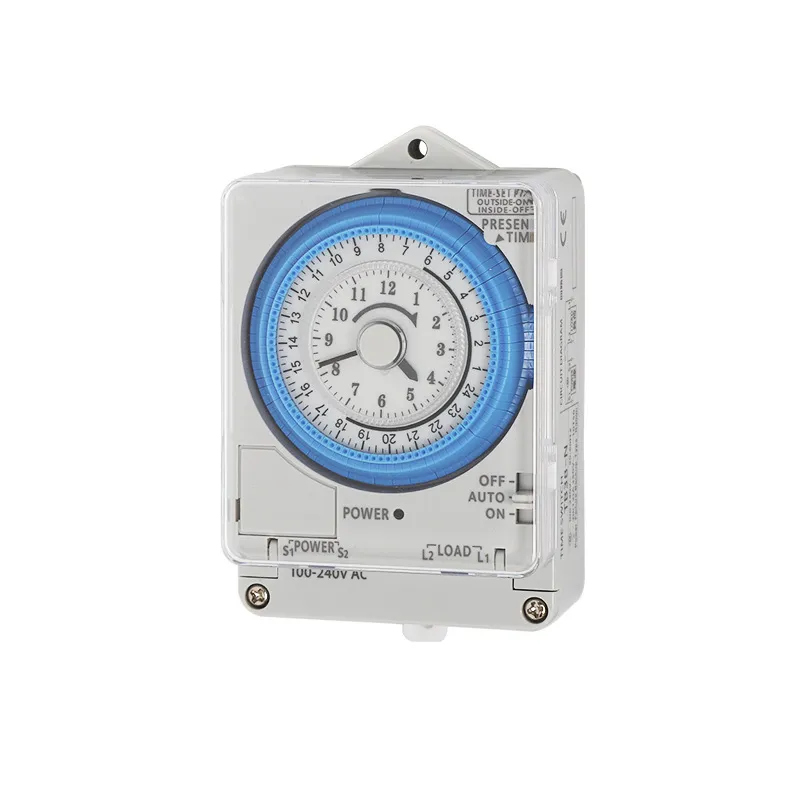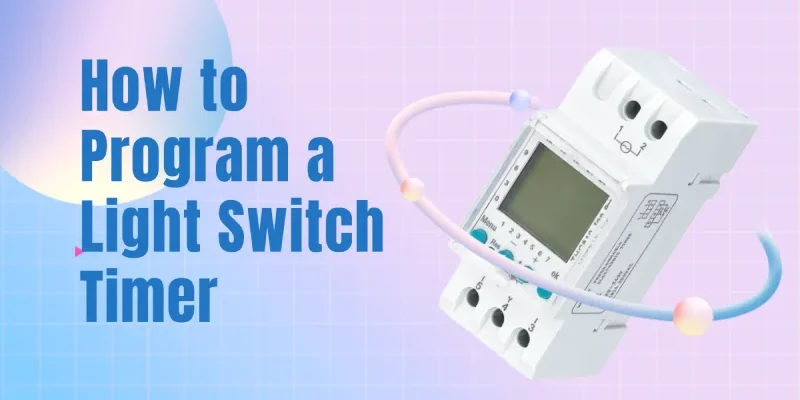Lichtschalter-Zeitschaltuhren bieten eine bequeme Möglichkeit, die Beleuchtung zu Hause zu automatisieren. Die Möglichkeiten reichen von einfachen mechanischen Geräten bis hin zu hochentwickelten digitalen Smart-Timern und sogar Arduino-basierten Heimwerkerlösungen. Die Programmierung dieser Zeitschaltuhren umfasst in der Regel die Einstellung der aktuellen Uhrzeit, die Erstellung von Ein- und Ausschaltzeitplänen und die Sicherstellung, dass das Gerät ordnungsgemäß an Ihre Beleuchtungsvorrichtungen angeschlossen ist.
Programmierung einer mechanischen Zeitschaltuhr

VIOX Mechanische Zeitschaltuhr
Mechanische Zeitschaltuhren bieten eine einfache und zuverlässige Möglichkeit zur Automatisierung von Beleuchtungsplänen, ohne dass digitale Schnittstellen oder eine komplexe Programmierung erforderlich sind. Diese Geräte verwenden in der Regel einen Drehknopf mit Stiften oder Laschen, um die Ein- und Ausschaltzeiten einzustellen. Hier erfahren Sie, wie Sie eine mechanische Zeitschaltuhr programmieren:
- Stellen Sie die aktuelle Uhrzeit ein, indem Sie das Rad drehen, bis der Pfeil oder die Anzeige auf die richtige Stunde zeigt.
- Stecken Sie die Stifte oder drücken Sie die Laschen zu den gewünschten Ein- und Ausschaltzeiten um das 24-Stunden-Zifferblatt herum.
- Vergewissern Sie sich, dass der Timer-Schalter auf "Timer" oder "Auto" eingestellt ist, nicht auf "Ein" oder "Aus".
- Für Wochenpläne verfügen einige Modelle über ein 7-Tage-Zifferblatt mit mehreren Reihen von Stiften.
- Die meisten mechanischen Zeitschaltuhren verfügen über eine manuelle Überbrückungsmöglichkeit, um das Licht außerhalb der programmierten Zeiten ein- und auszuschalten.
- Denken Sie daran, die Zeitschaltuhr während der Umstellung auf die Sommerzeit einzustellen.
Mechanische Zeitschaltuhren sind besonders nützlich für konsistente Zeitpläne und werden oft wegen ihrer Langlebigkeit und einfachen Handhabung in Anwendungen wie Innengärten oder Schildkrötenbeckenbeleuchtung bevorzugt.
Mehr erforschen
Programmieren einer digitalen Zeitschaltuhr
Digitale Zeitschaltuhren bieten erweiterte Funktionen und Flexibilität bei der Programmierung von Lichtplänen. Hier finden Sie eine Anleitung zur Programmierung einer typischen digitalen Zeitschaltuhr:
- Stellen Sie die aktuelle Uhrzeit und den Tag ein, indem Sie auf die Uhrentaste drücken und mit den Pfeiltasten nach oben/unten die Einstellung vornehmen.
- Rufen Sie den Programmiermodus auf, indem Sie die Taste "PROG" drücken.
- Wählen Sie mit der Tagestaste oder den Pfeilen den/die Tag(e) für den Zeitplan aus.
- Stellen Sie die "ON"-Zeit mit Hilfe der Stunden- und Minutentasten ein und drücken Sie dann die Eingabetaste.
- Stellen Sie die "OFF"-Zeit auf die gleiche Weise ein und drücken Sie dann erneut die Eingabetaste.
- Bei mehreren Zeitplänen wiederholen Sie den Vorgang für jeden gewünschten Ein/Aus-Zyklus.
- Vergewissern Sie sich, dass der Timer auf den Modus "AUTO" eingestellt ist, um den programmierten Zeitplan zu aktivieren.
Die meisten digitalen Zeitschaltuhren bieten eine manuelle Übersteuerungsoption, um die Beleuchtung außerhalb der geplanten Zeiten ein- und auszuschalten. Einige Modelle ermöglichen unterschiedliche Zeitpläne für Wochentage und Wochenenden, um eine bessere Anpassung zu ermöglichen.
Denken Sie daran, die Zeitschaltuhr bei der Umstellung auf die Sommerzeit anzupassen, obwohl einige moderne Modelle dies automatisch tun können. Digitale Zeitschaltuhren bieten im Vergleich zu mechanischen Alternativen oft eine präzisere Steuerung und die Möglichkeit, komplexe Zeitpläne zu erstellen, was sie ideal für Wohnungen mit unterschiedlichen Belegungsmustern oder speziellen Beleuchtungsanforderungen macht.
Mechanische und digitale Programmierung
Die Hauptunterschiede zwischen der Programmierung mechanischer und digitaler Zeitschaltuhren liegen in ihren Einstellmethoden, ihrer Präzision und ihrer Flexibilität:
- Einrichten: Mechanische Zeitschaltuhren verwenden physische Stifte oder Zungen auf einer drehbaren Skala, während digitale Zeitschaltuhren Tastendrucke zur Eingabe von Zeitplänen über eine digitale Schnittstelle erfordern.
- Präzision: Digitale Zeitmesser bieten eine größere Genauigkeit, oft bis auf die Minute genau, während mechanische Zeitmesser in der Regel 15-30-Minuten-Schritte haben.
- Flexibilität: Digitale Zeitschaltuhren ermöglichen komplexe Zeitpläne mit mehreren Tageszyklen und unterschiedlichen Wochentags-/Wochenendeinstellungen. Mechanische Zeitschaltuhren sind auf einfachere, sich wiederholende 24-Stunden-Zyklen beschränkt.
- Überschreiben: Bei beiden Typen ist in der Regel eine manuelle Übersteuerung möglich, aber digitale Zeitschaltuhren bieten unter Umständen ausgefeiltere Möglichkeiten der vorübergehenden Programmunterbrechung.
- Abhängigkeit von der Stromversorgung: Mechanische Zeitschaltuhren behalten ihre Einstellungen auch bei Stromausfällen bei, während digitale Zeitschaltuhren unter Umständen Pufferbatterien benötigen, um die Programmierung beizubehalten.
Aufgrund dieser Unterschiede eignen sich digitale Zeitmesser besser für abwechslungsreiche Zeitpläne und präzise Zeitangaben, während sich mechanische Zeitmesser durch ihre Einfachheit und Zuverlässigkeit für gleichbleibende tägliche Routinen auszeichnen.


